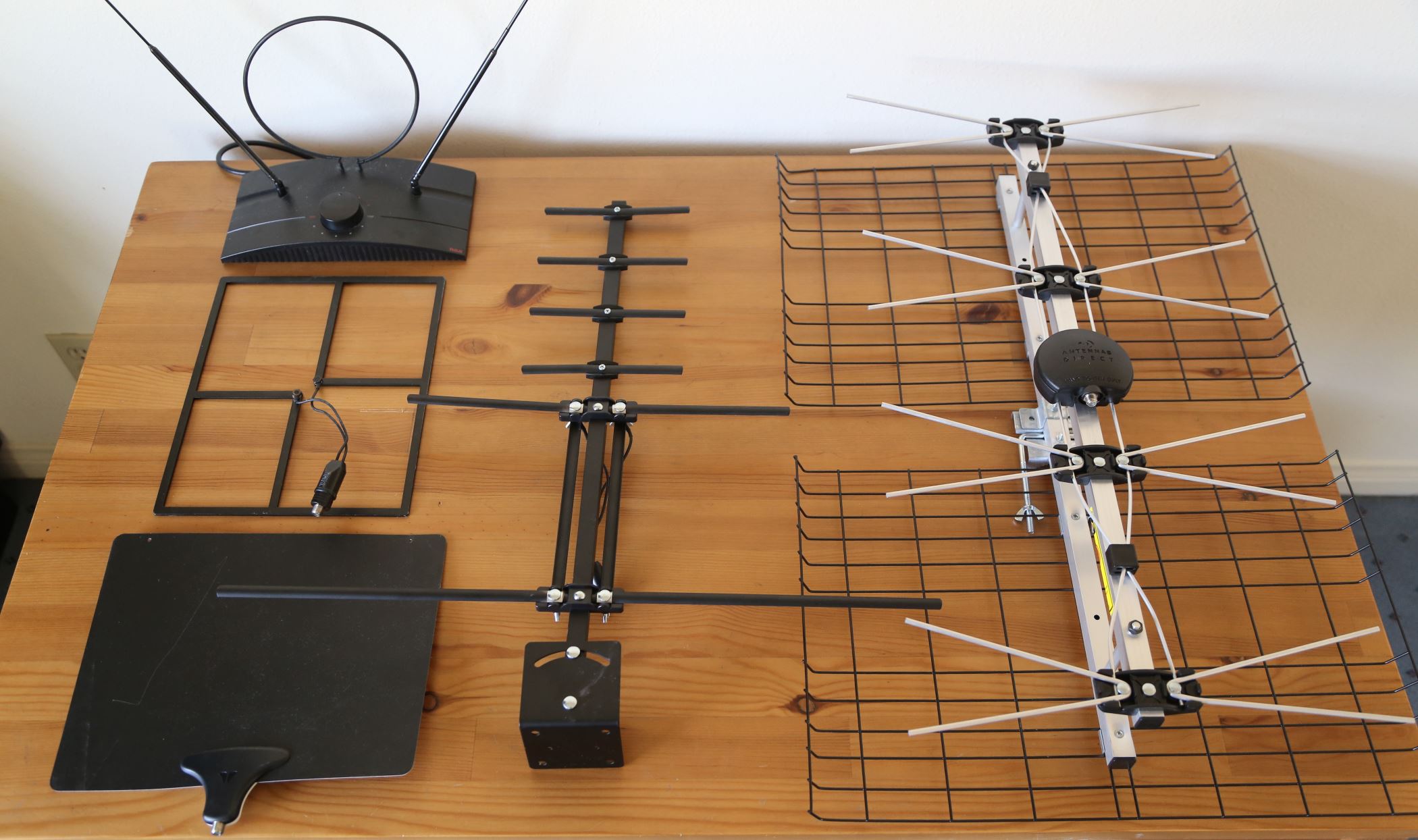The Best Indoor TV Antenna – The Great Antenna Shootout

I started using indoor TV antennas in 2010 when I first canceled my cable service in Providence, RI. Since then, I’ve moved to Los Angeles and have amassed a collection of different types of indoor antennas. I figured it was time to re-test my TV antennas to make sure I’m still recommending the best ones. After all, what worked well in Providence might not work well in Los Angeles, right?
The Antennas
So, here’s what I’m calling the “great antenna shootout”. I’ve taken a representative selection of different types of indoor TV antennas and tested them in my condo. These are the ones I tested:
- RCA ANT130B “rabbit ear” antenna (upper left)
- Mohu Leaf 30 (non-amplified) flat antenna (lower left)
- Channel Master STEALTHtenna 50 directional Yagi antenna (middle)
- Antennas Direct DB4 “bowtie” antenna with reflector (right)
These represent some of the most popular types of antennas from some of the leading antenna manufacturers. All are non-powered. Which was the best?

My Testing Method
In the past, I’ve taken a very clinical approach to testing, simply doing channel scans and recording the number of channels the antenna picks up. The one that picked up the most channels was the winner.
However, that is not necessarily a true reflection of the usefulness of an antenna. What most people really care about are a small number of channels, like the major networks, local English language stations, and PBS. Most people don’t care if an antenna picks up a whole bunch of foreign language stations and duplicates. What really matters are the “important” stations.
Thus, I’ve adjusted my testing method to just look at the major networks, English-language local stations, and PBS.
So let the tests begin! (Skip to the end if you want to see the winner).
Disclosure: Some of the links on this page are affiliate links. This means if you click on the link and purchase the item, I will receive an affiliate commission at no extra cost to you. I test or research each product or service before endorsing. This site is not owned by any retailer or manufacturer. I own this site and the opinions expressed here are mine. As an Amazon Associate, I earn from qualifying purchases.
Channel Master STEALTHtenna 50 (Yagi antenna)

The Channel Master STEALTHtenna 50 is technically an outdoor antenna, but it’s small enough to be used indoors. It’s known as a “Yagi” antenna, which is a very traditional design that you commonly see on rooftops. It’s a directional antenna, meaning it works well if all of your TV signals come from one direction, which they do in Los Angeles.
Sitting outside in my patio, this antenna was amazing and picked up pretty much every channel I wanted to get. But once I moved it inside, the situation deteriorated quickly. By moving it around, I was able to get a lot of channels, but I had to hold it in the middle of the room pointing at my window – definitely not the way I wanted to mount this thing in my living room.
So, while this was a good antenna, the bulkiness made it impossible to position in practice for maximum reception. When I placed in a more discreet location, the Mohu Leaf brought in more channels.
Having said that, the STEALTHtenna works wonderfully when used outside. It’s small enough to place in a patio. Read my full review of the STEALTHtenna when I tried it in my patio.
RCA ANT150 (“rabbit ear” antenna)

The RCA ANT150 is an old-school TV antenna with two telescoping arms and UHF loop. This antenna pre-dates digital broadcast TV, but still works for digital TV because the frequencies are the same.
For such an old antenna, it did surprisingly well and was able to pick up many stations. Unfortunately, I had to re-adjust the arms to pick up different stations – not something that is feasible in real usage. When left alone, it didn’t do as well as the Mohu Leaf. Plus, it was an eyesore. I don’t recommend purchasing this type of antenna.
Antennas Direct DB4 (“bowtie” antenna with reflector)

I had high hopes for the Antennas Direct DB4 antenna. This is the biggest and bulkiest antenna of the bunch, featuring four UHF bowtie antennas with a huge reflector.
But surprisingly, it didn’t do so well. I’m not sure why, but the flat Mohu Leaf brought in more channels. Even outside, the DB4 didn’t do as well.
On top of that, this antenna is so bulky that mounting options indoors would be extremely limited, further hindering its performance.
Mohu Leaf 30 (flat antenna)

Finally, I tested my trusty Mohu Leaf – the antenna I’ve been recommending for years. Would it still perform well in a totally new city?
The answer is “yes”! With careful placement, I was able to get the most channels! (Note that for all of these tests, I’m using a high-quality RG6 coax cable, not the RG59 cable that comes with the Leaf).
Like all of the antennas, it did suffer somewhat from what I call the “whack-a-mole” syndrome – i.e., you place the antenna to get good reception on one channel, only to mess up your reception on another.
But, I was able to find a happy medium that got me more channels than any other indoor antenna. And, because it’s thin, it’s easy to mount in a variety of positions.
I believe another advantage is that it bends, which seemed to help it pick up signals from different directions while the DB4 can only be used to pick up channels in one direction, for the most part.
The Winner – The Mohu Leaf 30!
So, the winner yet again is the Mohu Leaf 30! If you do get the Leaf, be sure to purchase a good RG6 coax cable with the correct length for it to reach a window in your home. The cable it comes with is not good.
Also, I got the Mohu Leaf 30 without amplifier, not the Mohu Leaf 50. Amplifiers only give improvement if all of your TV signals are weak. Otherwise, they can hinder your reception.
I also love the Leaf because it’s easy to mount and can be hidden without much effort. The importance of this is more than just cosmetics. Some of the other bulky antennas were good, but only when hanging in the middle of my living room – a non-starter!
Conclusion
Having said all of this, your results may vary. It’s impossible to tell which antenna will work best in a given situation.
If you’re happy with your antenna, DO NOT GO OUT AND BUY ANOTHER ONE. The differences between the antennas were subtle and positioning can have a bigger influence than antenna type.
By far, the most important thing you can do to improve your antenna reception is to move it outside. If that is not possible, here are more tips you can try.
What kind of indoor antenna do you use? Please leave your comments and questions below.
Keep in Touch – Subscribe for Free
If you liked this article, please sign up for email updates. I’ll send you a note when I publish a new article, no more than once every few months. Unsubscribe any time. – Brian








Well when I built my new home, after all the coax cable was run, I had the Antenna man in Perth come over and install what he mentioned was a log periodic TV antenna with an F type connector – he used this TV antenna https://www.antennadirect.com.au/
I think it was great that you went through some extensive research and conducted various testing in order to get the best indoor tv antenna placement. I’ve been having troubles with mine since last week and watching TV is one of my stress-relieving activities after a whole day of working hard. I think the best way to handle this is to avail for an antenna positioner solutions. This way, it will be handled by a qualified professional while I stay safe in my house. https://millibox.org/antenna
you are comparing a directional antenna (Bowtie & Yagi) with an Omnis (Rabbit and Flat), so its not a very good comparison. It really boils down to the direction the signals/power as well objects in the way.
My setup is everything I am interested in being in one direction and one station far away in another with very little reflection, so I have two directional antennas pointed in opposite directions, matched lines and combiner (splitter in reverse). At the combiner, I get a station 62 mi away unpowered and its an attic setup.
I`ve been using stream TV for last years but now I`m gonna instal a digitall TV antenna. Gonna use one of these – https://www.bestadvisers.co.uk/tv-antennas
HI Alex,
I would steer clear of the flat antennas that have the really thin built-in coax cable. Several readers and I have found that using good RG-6 coax cable can get you more channels. If you want a flat antenna, the Mohu Leaf has removable cable so you can swap in your own RG-6 cable of whatever length you need:
https://www.disablemycable.com/mohu-leaf/
Best,
Brian
I bought the Mohu antennae and haven’t installed it yet. When I go home today I’m going to try it. Hopefully it will give me some channels. Otherwise I stream Netflix and YouTube with my Roku.
Hi Marquita620,
Here are some tips to get better reception with your Mohu Leaf antenna:
https://www.disablemycable.com/antenna-tips/
Best,
Brian
Any idea why our large two-bladed (like really large) RCA digital antenna would pull in 15 or so channels with our Panasonic Plasma but only brings in 4 with our new Roku TV? Just the TV is different. And yes, I double checked the connections.
Hi Rob,
If your setup is exactly the same, the only remaining culprit is the quality of the TV’s tuner electronics. This can vary from TV to TV due to the printed circuit board layout, quality of electronic components, internal electrical interference, and so forth. Unfortunately, it sounds like the Roku TV’s tuner is just not as good as Panasonic’s.
You can either try to improve your TV signal with an amplifier, better cable, different positions, etc. or use a different tuner, such as one that in a DVR:
https://www.disablemycable.com/dvr/
Hope this helps,
Brian
I live in Michigan about 35 miles from all of the towers of the major networks (http://www.tvfool.com/?option=com_wrapper&Itemid=29&q=id%3de6a4e1faadf8c1). I’m using an RCA ANT1750Z indoor antenna with the included amp. I can pick up NBC, ABC, and PBS (on a good day, and better in the morning at that), but not FOX. Funny thing is when looking at the link above, all of the towers are really only a few miles apart. I have a cathedral ceiling in my living room, and my antenna is wall-mounted near the very top, about 14 feet up and pointing in the general direction of the towers. I’ve thought about getting a different pre-amp to use along with an LTE filter. Do you think this would help pick up the other channels in my area? If not, do you have any other recommendations? I do not believe that my HOA allows mounting of outdoor antennas (but they do allow satellite dishes). Thanks!
Hi Mike,
I have a couple of pieces of advice:
– before buying a new antenna, make sure your preamp is as close as possible to your antenna, and not at the other end near your TV. Yes, I know it’s probably a pain to get power up there but that’s the ideal setup.
– FYI, Federal law prohibits HOAs or other organizations from stopping you from installing an outdoor TV antenna as long as it’s on your roof area. It is your right to do it.
– If you are not able to get better reception with this antenna, an outdoor antenna would be ideal. If you’re still not able to do that, get an indoor one with detachable cable, so that you can use high-quality RG6 cable.
Best,
Brian
Hi, Brian. Thanks for the advice. Do you think a different pre-amp other than the one that came with the antenna would do better?
Hi Mike,
I can’t promise better results, but in my experience, stand-alone amps perform better than ones that come with cheap antennas, so I’d say it’s worth a try. Here’s one that I’ve tested and worked better for me:
http://amzn.to/2tW0DSS
Best,
Brian
I live in W. Iowa and draw stations from Des Moines (67 miles away). I have an antenna and amp installed in my attic and can draw all stations well, EXCEPT our ABC affiliate (WOI). Unfortunately, they’re on a low-band VHF channel which is difficult to get. Should I supplement my current Yagi-style antenna with another low-band VHF style or would that create interference with my other antenna? Thanks!
Hi Jon,
I don’t think the antenna signals would interfere with each other but hard to say without actually trying it. Just be sure to place the amp after you combine the two antenna signals (but still close to the antennas and not down the line). It’s probably a long shot but could be worth trying if there is a good return policy on the VHF antenna.
Best,
Brian
Appreciate your input! Talked to another cord cutter and he had learned that low VHF signals are pretty susceptible to interference, so could just be a lost cause. : (